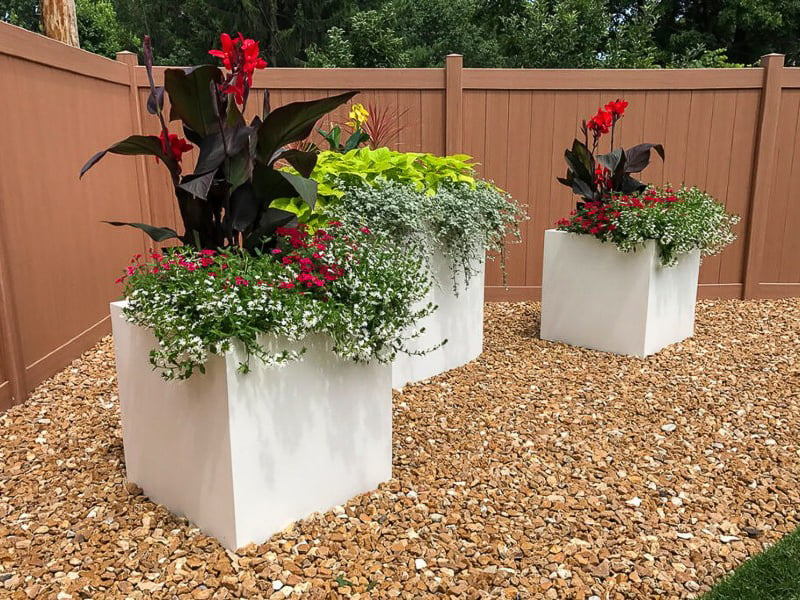From water and sunlight to soil and fertilizer, there are many important factors to consider when it comes to plant health.
However, often overlooked in container gardening, choosing the best plant pot sizes is extremely important.
The great Maya Angelou once said, “The ache for home lives in all of us.” And believe it or not, that includes plants, too! Think of plant pots as homes for our green friends – these containers are a place of refuge from the elements and a sanctuary of their own where they can grow and thrive.
If your pot size isn’t correct, then your plant is likely to suffer from stunted growth, brown or droopy leaves, and generally just not look their best, even if you provide the perfect water, sun, soil conditions, and location for your containers.
So whether you’ve just brought home a new plant from the nursery or you’ve noticed that one of your favorite plants is looking under the weather, it might be time to consider a size change for your pot or planter.
Interested in more than just size? Learn more about how plant pot shapes affect your plant and how to use them!
Does Plant Pot Size Really Matter?
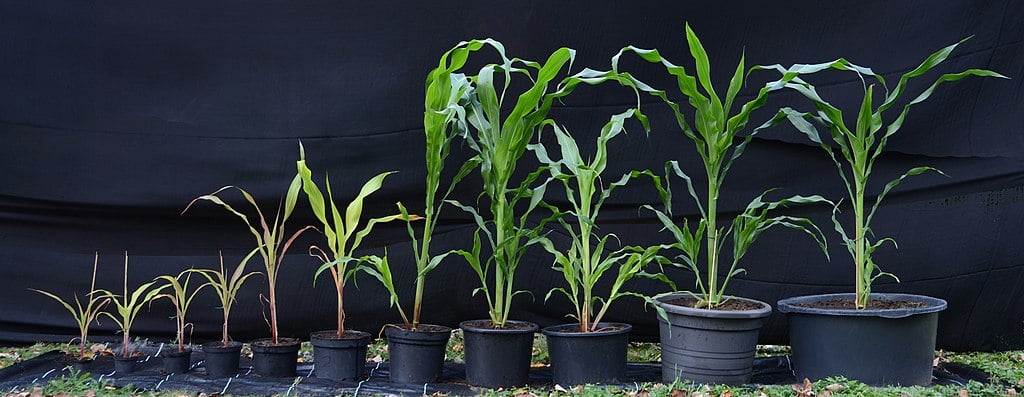
The short answer is yes – choosing the right size pot for your plant is very important!
Of course, water, sun, and soil requirements are arguably just as important. Too much or too little water can be a death sentence for your favorite plant in any container. Incorrect soil or sun conditions can also cause the same problems that an incorrect-size pot does.
But assuming that all other conditions are already perfect, let’s discuss the havoc that an incorrect-size pot can wreak on your plant.
Tips For The Best Plant Pot Sizes
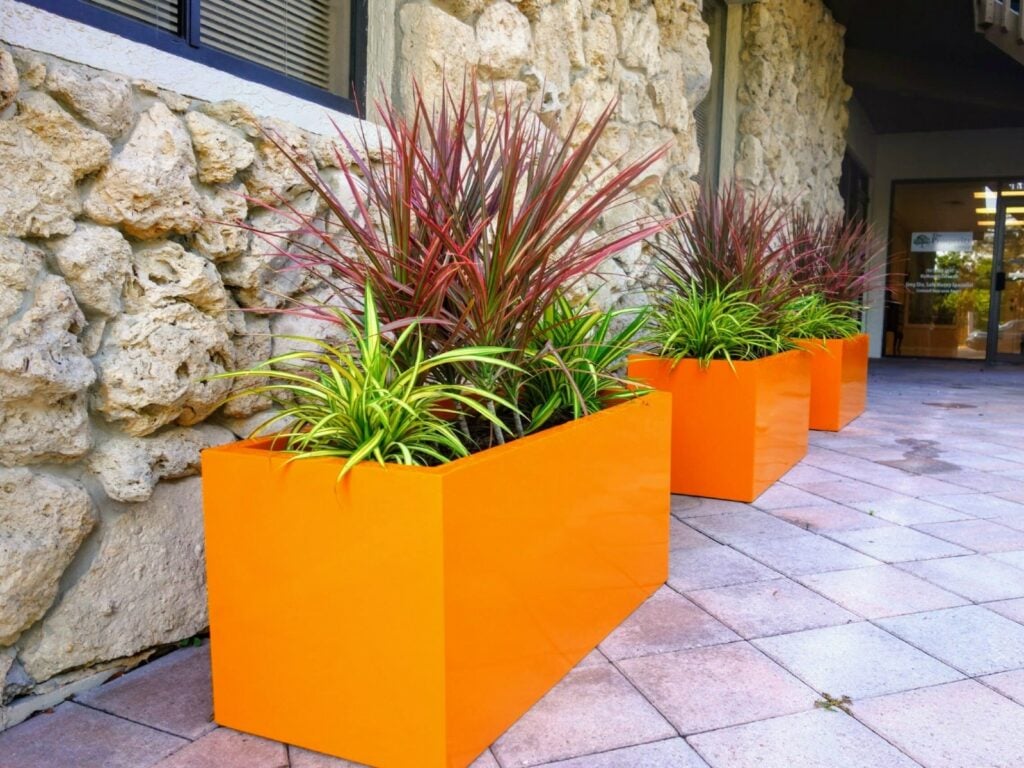
Tips for small planters and large plants
Oftentimes, plant pots are not big enough. If you start to notice roots peeking through the drainage holes of your pot, it’s time to re-pot your plant.
If your container is too small, the plant’s roots are more likely to get crowded, resulting in slow or stunted growth or even a complete halt in growth. This happens because the roots pack the soil in, creating an impenetrable force against water. So your plants end up becoming dehydrated, and usually, this presents as wilted, yellow, or brown leaves, and it’s time you invested in larger containers.
Related article: How do Self-Watering Pots Work?
To save your root-bound plants, you’ll have to give them a little TLC before you transplant them to a larger pot. Start by trimming any roots that have grown through the drainage hole, then carefully remove the plant from the pot.
If you find a root ball near the very bottom of the pot, don’t panic. If your plant is only slightly root-bound, you can use your fingers to gently massage the root ball and break up the tangled roots leaving room for the drainage holes to remove excess water.
But if the roots are very tangled and packed together, you may need to cut into the root ball with a knife to encourage new growth. For best results, try to do this early in the morning or after sundown so that you don’t expose the damaged roots to too much harsh afternoon sun.
Finally, choose a pot that is 2-4″ inches larger and place your plant in its brand-new home with fresh soil. Remember to keep a close eye on your plant for the next few days, especially if you had to cut out a large root ball, as it will be extremely vulnerable until the new roots are established.
Related article: The 3 Stages of Plant Growth
Tips for large planters and small plants
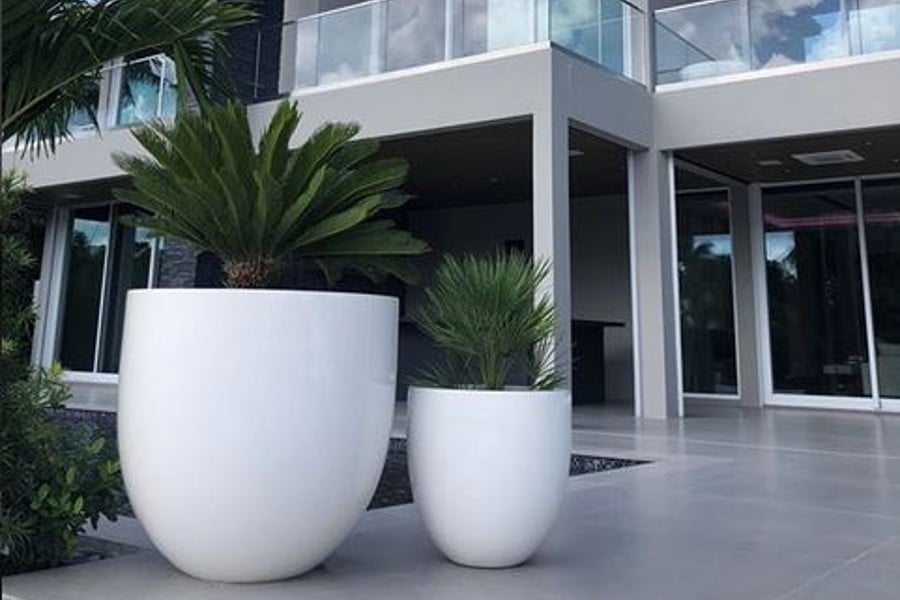
On the other hand, if your pot size is too big, excess water can pool, essentially drowning your plant and cutting its roots off from necessary oxygen. This is one major cause of root rot, which can then spread to other healthy roots, especially if water has pooled long enough to allow fungi to grow.
Often smaller plants in tall pots are susceptible to this kind of issue and pot fillers can help to aerate the soil deeper in the tall pot.
To reverse the damage caused by root rot, place your plant’s roots under running water to remove any contaminated soil. Then identify the affected areas and remove them. Finally, place the plant in a clean pot with fresh soil and monitor it carefully over the next few days to make sure the root system recovers.
How Are Plant Pot Sizes Measured?

The two most common ways in which pot manufacturers measure their pot sizes are inches and gallons.
Inches refer to pot diameter, also known as the total length in inches across the circular opening of the pot. Many round pots are measured in inches because it is much easier to find the diameter of a circular, round pot than other pot shapes.
Gallons refer to container volume. If you have a uniquely shaped pot, the manufacturer may use gallons to indicate the size of the planter.
Since pots come in many different shapes and container sizes, it’s important to check with the pot manufacturer or a garden center to make sure it’s an appropriate container size for your plant.
Related article: How to Take Care of Indoor Plants
What Are Standard Planter Sizes?
To calculate equivalencies between inches and gallons, the general rule of thumb goes like this: a 1-gallon pot is equivalent to 8 inches. For every increase of 2 inches in pot diameter, the pot increases by 2 gallons.
Ideas for a 10-inch pot
(3 Gallons)
- Small herbs, such as mint or basil
- Up to 3 annuals
- One medium-sized warneckii dracaena
Ideas for a 12-inch pot
(5 Gallons)
- Leaf lettuce
- Other leafy vegetables, like spinach or kale
Ideas for a 14-inch pot
(7 Gallons)
- Larger herbs, such as rosemary
- Sage
- Lavender
Ideas for a 16-inch pot
(10 Gallons)
- Small shrubs
- Small fruits, such as raspberries and strawberries
Ideas for an 18-inch pots
(15 Gallons)
- Mixed annuals
- Larger vegetables, like tomatoes
Ideas for a 24-inch pot
(25 Gallons)
- Evergreen shrubs
- Dwarf citrus tree
Ideas for a 30-inch pot
(30 Gallons)
- Orchard fruit trees, like apples and orange
- Larger plants and trees
Standard Planter Size Chart
Choosing the right pot size for your garden shouldn’t be difficult, so we created this handy chart for standard pot sizes. However, there are lots of different pot manufacturers and styles out there, so actual size will vary depending on factors like brand and shape.
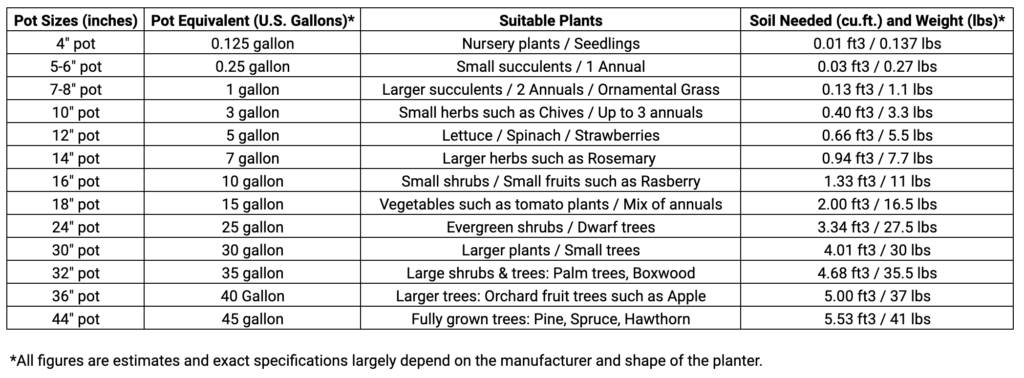
Finding The Right Pot
Owners of indoor plants don’t just want our green friends to survive, we want them to thrive! To give our plants a long, healthy life, it’s important to choose the best container sizes.
Growing beautiful plants requires several factors, and the right size pot is only one of them. Without the correct pot size, the plants in your container garden are more likely to suffer from a number of problems, from root rot to root balls.
In order to keep your growing indoor plants at their best, you should consider upgrading to a larger pot every 1-2 years. Once you start to notice slow growth despite optimal sunlight and water conditions, it’s time to consider pot sizes as the issue.
After reading this guide, you should have a pretty good idea of what size pot you need to make your plants feel at home. But what planter materials should you choose?
Plastic pots are an option, but they don’t withstand the elements very well from season to season and will crack and break, especially when kept outdoors.
That’s why our preferred planter material is fiberglass. Fiberglass planters are extremely durable, weather-resistant, and super easy to maintain. Suitable for both indoor and outdoor container gardening, fiberglass will keep its integrity throughout many growing seasons and is the preferred choice in all kinds of landscape settings.
Read more about why we only offer fiberglass planters.
See How Planters Etcetera Planters Are Used
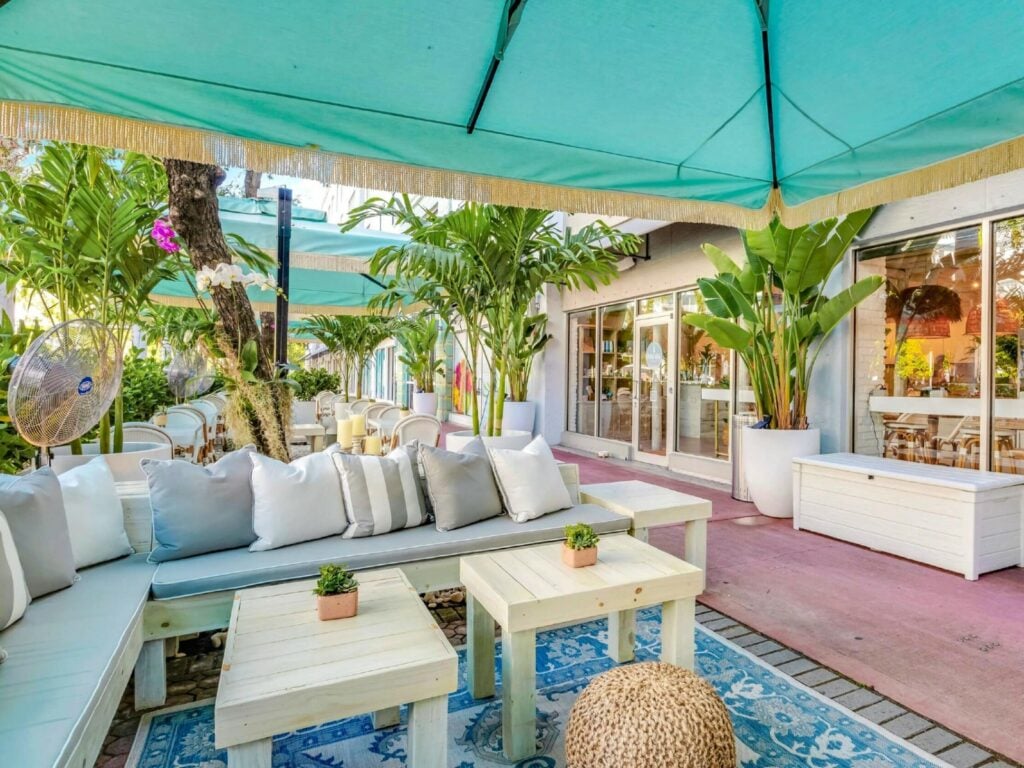
Planters Etcetera planters were the perfect solution for this resort. With a large property to specify for, many different planter sizes were used to meet the varied needs of the commercial space.
Learn more about this project!
Find The Perfect Pot Size With Planters Etcetera Fiberglass Planters
Since fiberglass can be molded into any shape, this provides a lot more flexibility and design innovation than traditional planter materials, like terracotta and ceramic.
In short, our planters will match, enhance, and complement any décor. Visit our shop to browse our huge inventory of planter sizes and shapes, ranging from traditional styles to clean, modern lines.
We can even fabricate custom planters to achieve the perfect size or shape for your plant. Contact us today and we’ll be happy to help you create a custom planter for your residential or commercial container gardening project.
